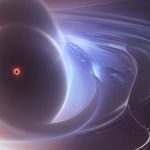Key Takeaways:
- New theory suggests universe expands by merging with other universes, challenging traditional ideas.
- Scientists propose “baby” universes collision as explanation for accelerated expansion, offering intuitive alternative.
- Mathematical model shows merging universes could explain observed expansion better than standard theory.
- Theory also addresses cosmic inflation, suggesting early universe expansion due to absorption by larger universe.
- Observational data from ongoing experiments crucial to confirm or refute hypothesis, awaiting results from telescopes like Euclid and James Webb.
Our universe is getting bigger and bigger really fast — something all the theories about space agree on, but none of them can totally explain. Now, there’s a new idea in town: Maybe our universe is expanding because it keeps bumping into and soaking up “baby” universes.
When scientists look at the afterglow of the Big Bang, known as the cosmic microwave background, they see that our universe is swelling up quicker and quicker. To make sense of this, physicists use something called the Standard Cosmological Model, which says there’s this weird stuff called dark energy pushing the universe to expand.
But this dark energy is so mysterious that no one’s seen it in any other way. So, some space scientists are asking, “Is there something else making the universe get bigger?”
In a new study in the Journal of Cosmology and Astroparticle Physics, scientists threw out the idea that our universe could be expanding because it’s constantly bumping into other universes.
“The big discovery from our research is that maybe the fast expansion of our universe, because of the weird dark energy, might have a simple explanation: it’s joining up with these ‘baby’ universes. And it seems like this idea fits better with the data than the usual cosmological idea,” said Jan Ambjørn, the main scientist behind the study, who works at Copenhagen University. He told LiveScience about this in an email.
Gobbling up cosmic ‘babies’ People have talked about other universes touching ours before, but this study did some serious maths to figure out what might happen if that was true. According to the researchers’ calculations, if our universe is joining up with others, it should get bigger, which would look like the universe is expanding when we look through our telescopes.
The scientists also worked out how fast they think the universe is getting bigger using this idea, and it fits better with what we actually see in space compared to the usual idea, they said.
This idea also tackles another big question in space science: why the universe got really big really fast just after the Big Bang.
Before, scientists said this happened because of something called “the inflaton” — a made-up thing that made the universe get really big in the first few milliseconds after the Big Bang. But in this new study, the scientists suggest that maybe this super-fast early expansion happened because our baby universe was swallowed by a bigger one.
“The fact that the Universe got huge really fast suggests maybe it was because it bumped into a bigger universe, like our Universe was swallowed by another ‘parent’ universe,” the scientists wrote in their paper. “We don’t know exactly how this swallowing happened, so it’s hard to say if this idea could really explain why inflation happened like it did. But one interesting thing about this idea is that we don’t need the inflaton anymore.”
The scientists say that after our universe got swallowed, it kept crashing into other baby universes and making itself even bigger.
Even though this idea helps us understand some big questions about space, we can’t be sure it’s true until we have more evidence. Right now, lots of experiments are happening to look at the cosmic microwave background, so maybe we’ll get answers soon.
“The way our Universe is getting bigger now is different from what the usual cosmological ideas say, and we think the Euclid telescope and the James Webb telescope will help us figure out which idea is best,” said Yoshiyuki Watabiki, a scientist at the Tokyo Institute of Technology, talking to Live Science.


